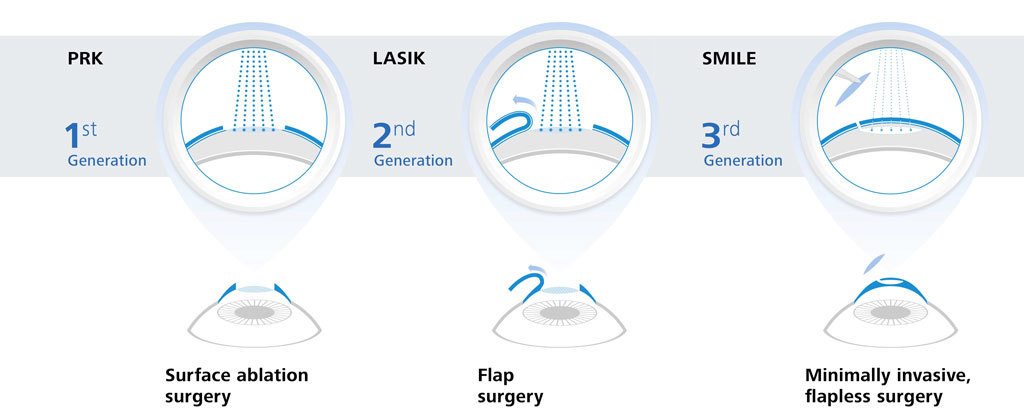Interested In Discovering The Differences Amongst SMILE, LASIK, And PRK Procedures For The Eyes?
Interested In Discovering The Differences Amongst SMILE, LASIK, And PRK Procedures For The Eyes?
Blog Article
Published By-Weber Copeland
If you've been thinking about SMILE eye surgery, you may wonder exactly how it compares to LASIK and PRK. Each procedure has its very own collection of benefits and considerations. From quicker healing times to possible risks, there are crucial differences you ought to understand before choosing. Recognizing these distinctions will certainly help you make an informed option that straightens with your details requirements and assumptions. Curious to know more regarding exactly how these procedures compare thoroughly? Continue discovering to obtain a thorough understanding of SMILE, LASIK, and PRK.
SMILE Eye Surgical Procedure Review
If you're taking into consideration SMILE eye surgery, you'll find it to be a minimally intrusive procedure with a quick recuperation time. Throughout SMILE (Small Incision Lenticule Removal), a laser is utilized to create a small, precise cut in the cornea to eliminate a small item of tissue, improving it to remedy your vision. This varies from LASIK, where a flap is created, and PRK, where the outer layer of the cornea is completely eliminated.
One of the vital benefits of SMILE is its minimally intrusive nature, bring about a faster recovery process and less pain post-surgery. The recovery time for SMILE is relatively fast, with many individuals experiencing boosted vision within a day or more. This makes it a popular selection for those looking for a convenient and reliable vision adjustment procedure. Additionally, SMILE has actually been shown to have a lower risk of dry eye disorder contrasted to LASIK, making it a positive alternative for people worried regarding this possible side effect.
Differences Between SMILE, LASIK, and PRK
When comparing SMILE, LASIK, and PRK eye surgical treatments, it is very important to recognize the unique strategies used in each treatment for vision modification.
SMILE (Tiny Cut Lenticule Extraction) is a minimally invasive treatment that entails producing a small incision to draw out a lenticule from the cornea, improving it to deal with vision.
LASIK (Laser-Assisted Sitting Keratomileusis) includes producing a slim flap on the cornea, using a laser to improve the underlying tissue, and then rearranging the flap.
PRK (Photorefractive Keratectomy) gets rid of the outer layer of the cornea before improving the cells with a laser.
The major distinction lies in the method the cornea is accessed and dealt with. SMILE is flapless, making it a great choice for people with thin corneas or those involved in get in touch with sports. Vision Correction Techniques provides quick aesthetic recovery due to the flap development, however it may position a higher risk of flap-related issues. PRK, although having a longer healing period, stays clear of flap-related problems completely.
Recognizing these differences is important in picking the most ideal treatment for your vision improvement demands.
Pros and Cons Contrast
To evaluate the advantages and downsides of SMILE, LASIK, and PRK eye surgeries, it's essential to consider the details advantages and potential constraints of each procedure. SMILE surgery provides the benefit of a minimally intrusive procedure, with a smaller sized laceration and possibly quicker recovery time contrasted to LASIK and PRK. It likewise lowers the danger of completely dry eye post-surgery, a typical negative effects of LASIK. Nevertheless, SMILE might have restrictions in treating higher degrees of myopia or astigmatism compared to LASIK.
LASIK surgical procedure supplies quick aesthetic recuperation and very little discomfort throughout the procedure. It's very efficient in treating a wide range of refractive errors, consisting of nearsightedness, hyperopia, and astigmatism. Yet, LASIK carries a threat of flap problems, which can impact the corneal framework.
PRK eye surgery, while not as popular as LASIK, stays clear of producing a corneal flap, reducing the risk of flap-related difficulties. It appropriates for clients with thin corneas or irregular corneal surfaces. However, PRK has a much longer recuperation time and might involve more discomfort during the healing process.
Conclusion
So, when it comes to selecting in between SMILE, LASIK, and PRK, think about it like picking the excellent set of shoes. SMILE is like a sleek, comfortable pair of sneakers - fast and simple.
LASIK is a lot more like fashionable high heels - flashy and fast, yet with some potential dangers.
PRK is like durable treking boots - trustworthy and long lasting, but calling for a bit even more effort and time.
Ultimately, the best selection depends upon your private needs and preferences.
